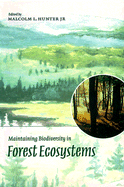Book contents
- Frontmatter
- Contents
- List of contributors
- Foreword
- Preface
- Part I Introduction
- Part II The macro approach, managing forest landscapes
- Part III The micro approach, managing forest stands
- 10 Dying, dead, and down trees
- 11 Vertical structure
- 12 Plantation forestry
- 13 Special species
- 14 Genetic diversity
- Part IV Synthesis and implementation
- Index
11 - Vertical structure
Published online by Cambridge University Press: 20 February 2010
- Frontmatter
- Contents
- List of contributors
- Foreword
- Preface
- Part I Introduction
- Part II The macro approach, managing forest landscapes
- Part III The micro approach, managing forest stands
- 10 Dying, dead, and down trees
- 11 Vertical structure
- 12 Plantation forestry
- 13 Special species
- 14 Genetic diversity
- Part IV Synthesis and implementation
- Index
Summary
Looking up at a 50 meter tall Ceiba pentandra in Panama, or a 60 meter dipterocarp in Borneo, or a 70 meter Douglas-fir (Pseudotsuga menziesii) in Oregon, you know that forests are, above all, vertical. Even in short forests the dimension from ground to canopy includes layers of foliage, gradients of microclimate, and a diversity of plants and animals that respond to that vertical structure. Human use of forests alters those layers, those gradients, and those arrays of plants and animals. In a world where more and more forest is disturbed, our goal in this chapter is to develop an understanding of vertical structure and its relation to biodiversity, and to suggest ways that forest management can maintain the vertical structure that supports biodiversity.
The study of animals and vertical structure has at least an 80 year history. Early in this century ecologists visualized strata in forests and recognized that different animals frequented different strata (Shelford 1912). At mid-century ecologists took another step, showing that differences in the complexity of vertical structure could explain differences among forests in diversity of birds (MacArthur and MacArthur 1961). While later studies showed that more than vertical structure is needed to explain diversity (James and Wamer 1982), no one disputes that a vertically complex forest generally supports more species than a simple forest. Meanwhile, foresters have increased their knowledge of how forest development and management determine vertical structure (Oliver and Larson 1996), and at century's end ecologists and foresters are applying these accumulated insights to conservation (DeGraaf et al. 1992, Franklin et al. 1997).
- Type
- Chapter
- Information
- Maintaining Biodiversity in Forest Ecosystems , pp. 373 - 399Publisher: Cambridge University PressPrint publication year: 1999
- 54
- Cited by

